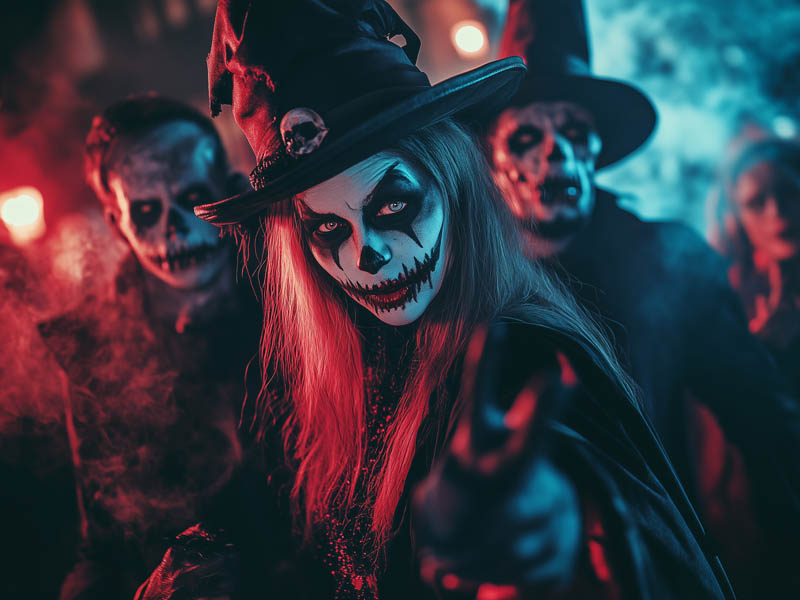
Share:
Drs. Neil Sutherland, Rachel Wolfgramm, and ILA Fellow Dr. Richard Bolden consider what we can learn about leadership from the traditions of Halloween. They suggest that ghosts, vampires, werewolves, and zombies can be considered as archetypes, representing our deepest fears, yet also as potential metaphors to unmask the hidden and uncanny aspects of leadership.
- 19 October 2024
Call for Chapters
The authors of this article have been commissioned to edit a book on Ghost Leadership: Uncovering the Hidden and Unsettling Sides of Leadership for the ILA and Emerald Building Leadership Bridges book series. To find out more and to submit a chapter proposal please read the complete CFP. The Deadline for initial outlines is 18th November 2024.
Trick or Treat(ise)
Halloween (see Notes for a discussion of Halloween’s roots) is an inherently liminal time and space — straddling Autumn and Winter (in the temperate regions of the Northern Hemisphere at least), the natural and the supernatural, feast and famine, life and death — a period where normal rules, categories, and identities are momentarily suspended, and change, transformation, experimentation, and play come to the forefront. Despite increasing commercialization, Halloween is still fundamentally centered on the fear of the unknown, unseen, and unsaid, and allows a temporary and anarchic zone of ambiguous groupings.
Of course, these kinds of periods also enable a space for pause and reflection —for sensemaking and understanding (or perhaps questioning) our own taken-for-granted rules and assumptions. When normal service is suspended, it allows us a glimpse behind the curtain, and this is regularly felt with the deep examination that Halloween offers of inclusion and exclusion in society. Indeed, Halloween provides us a lens to examine the place of “outsiders”’ and notions of societal belonging — whether that be the monsters and ghouls that descend onto mortal soil or how those traditionally marginalized in society (such as children) may take on more dominant roles during the time. After witnessing safe structures being inverted and previously invisible forces bubbling up, when the dust settles, we emerge with a deeper understanding of “normal” life — perhaps more appreciative, perhaps more questioning. We are granted a view of the “strange.”
This offers up a powerful opportunity to explore leadership dynamics in organizations. What can we learn from the temporary suspension of convention at Halloween that can enable us to see leadership in new ways in our organizations? How can we ask different questions about the unseen and unsaid? About hidden forces? About mortality and vitality? About individual and organizational identities, and how they may typically serve to marginalize and disempower? And, unlike the short-term (and often superficial) suspension during Halloween, can we develop our own capacity to adopt this questioning mindset as a permanent part of our organizational experience?
Facing Our Monsters
The phantoms and monsters that have come to characterize the festival of Halloween can be considered as archetypes that provide insight into our greatest hopes and fears. In what follows we will consider four of the most widely known Halloween monsters — ghosts, vampires, werewolves and zombies — as productive metaphors to unmask the hidden and uncanny aspects of leadership.
Ghosts — The importance of Culture and Place
Ghosts are amongst the most ancient manifestations of the supernatural. One of the earliest accounts is attributed to Pliny the Younger, who wrote in first century CE of an old, bearded man with rattling chains haunting his house in Athens (History.com, 2023). Ghosts, phantoms, and spectres are ubiquitous — with stories in most, if not all, communities around the world. A common notion underpinning ghost lore is the separation of the body and soul — with ghosts being those unfortunate spirits that, when freed from their bodies, become trapped between life and the afterlife (a space previously referred to as “purgatory”).
In her book The Ghost: A Cultural History, Susan Owens (2017) suggests that ghosts serve two main functions within society — firstly to remind us of the inevitability of death and secondly to offer reassurance that death is not the end. Through popular culture, ghosts vary hugely in temperament, from benevolent (e.g., Casper the Friendly Ghost), through benign (e.g., many of the Hogwarts ghosts in Harry Potter), eccentric and unpredictable (e.g., Beetlejuice), to outright malevolent (e.g., Freddy Kruger). The scariest ghosts, however, are perhaps those that we cannot see — either lurking in the shadows or simply invisible.
In applying the ghost metaphor to leadership, several points come to mind. Firstly, ghosts are usually a sign that something is amiss — that a soul hasn’t passed through to “the other side;” that something terrible happened in a particular place; or that some wrongdoing has occurred (such as the building of houses on burial grounds in the films Poltergeist and Amityville Horror). Secondly, ghosts remind us of the situatedness of experience — ghosts don’t, by and large, turn up at random but are integrally linked to the people and/or places they haunt. And thirdly, there is the importance of stories and storytelling in making sense of who the ghosts are and why they do what they do. Key themes we might consider here are the importance of organizational culture and the need to acknowledge and, if necessary, purge the spirits of the past to move forward. We might also consider aspects of place-based leadership and the interconnections between workplaces & organizations, cities & communities, countries & societies, and virtual & imagined worlds (Sutherland et al., 2022). Finally, we might be encouraged to consider the experience of being “haunted’” — as similar to a followers’ account of the legacy and impact of their experiences (good and bad) in relation to the ghostly “leadership” influences around them.
Vampires – The Complexities of Ascension
The typical theme surrounding vampires is one of ascension — where, following their conversion, an ordinary human suddenly experiences immortality, previously unknown power, and now occupies a permanently hierarchical position above mortal beings. Leaders may find themselves experiencing a similar transformation through promotion up the ranks (Kempster & Stewart, 2010). Like vampires, they may find that their worldview is shifted — peers becoming subordinates, power imbalances straining relationships, and becoming detached, perhaps, from their more “human” tendencies and emotions, finding them replaced with a focus on broader concerns and strategic goals that they didn’t consider previously — without which, survival would be impossible. Indeed, leaders may be aware of the potential for leaving permanent marks on their organizations and people they lead — where their policies, visions, and impacts can not only be perceived of as unquestionable, but also conceivably lasting long after their time in a formal leadership role ends.
The challenge throughout this is to understand that the archetypal tale of a vampire is of one who has lost their empathy with their previous kind, becoming hyper-individualistic and seeing the question of survival as a solo pursuit reliant on others being “drained” (Godwin, 2012). Within organizations, this power, if left unchecked, can quickly become destructive — either through exhausting morale or even, intersubjectively, “destroying” their team. As mortals, we have the opportunity to resist those vampiric tendencies. We have the agency to contest the temptation to see a leadership role as one that comes with irrefutable authority and instead balance our newfound power with empathy and compassion — driving for a sustainable influence rather than exponentially extracting from those around us.
Through this, we can see that the metaphor of the vampire helps us to understand how leaders might frame their roles differently, but that this also involves a complex renegotiation of the self in the process. Whilst conversations around the anxiety that accompanies leaders is still surprisingly scarce, portrayals of vampires do regularly focus on the challenges and complexities of their new position — coming to terms with their new power (and often over-stepping the boundaries in their early stages), loneliness, the requirement for training, understanding their severed relationships, and renegotiating their places in society. From Dracula, to True Blood, to Twilight, the story of the vampire is laced with sorrow as well as aspiration. Thus, in addition to understanding the impact of leaders on their teams, the vampiric metaphor also may help us to understand in more complex detail the journey of the individual who finds themselves transformed. Whilst promoting an aspiration for power is common within Western cultures, much less is dedicated to exploring and coping with the contradictory feelings that come afterwards — emotions that leaders may feel make them an imposter and that subsequently encourage them to fall back to occupying the “default” position of wielding power over others. Perhaps this offers us the opportunity to follow in the footsteps of tales of vampires, and bring in the messy, contested, and complicated emotions that come with ascension to powerful positions. Our following reflection on the experience of werewolves delves further into this complexity.
Werewolves – The Crisis of Self
In folklore, a werewolf (lycanthrope) is a human who involuntarily transforms into a wolf at full moon. Werewolves represent the manifestation of primal human instincts with energies and fearlessness fueled by desires for power and freedom whilst at the same time, offering loyalty. Symbolically, werewolves represent the underlying struggle between good and evil in the human psyche, one that is captured in the identity crisis that occurs in the human-wolf-human liminal states.
Werewolves offer fertile ground to study identity transformation and crisis given that symbolic, agentic, and experiential transformation aid understanding the liminality of identity struggles (Belk, 1988, 2013; Schouten, 1991). Applying liminality theory (Beech, 2011; Cody, 2012) the ability to integrate new self-concepts is vital for human-werewolves as they transition from one stable way of structuring their identity to another, letting go of their old identity before their new one can be established. Whilst in transitory mode, the human-werewolf teeters on thresholds (literally “līmen”) often portrayed as struggling with the multiple possibilities of what they will become. The identity struggle includes the uncertainty of what will occur whilst transformed and how the new, reassembled identity will manifest. The fears, fantasies, and desires of the new, wilder human-werewolf on the threshold capture endless possibilities.
A vivid illustration of this is Martin Parker’s (2004) autoethnographic account of taking on the role of Head of Department at Keele University and the challenges of assimilating this alongside his professional identity as a Critical Management Studies scholar. The title of the article — Becoming Manager: Or, the Werewolf Looks Anxiously in the Mirror, Checking for Unusual Facial Hair — powerfully captures the very real struggles experienced (yet rarely discussed) by people in such situations. Liminal identity is conceptualized as “a threshold state of existence that involves the dissolution of one self-whilst reflexively recrafting a new self” (Beech, 2011). This highlights that liminality occurs at the intersection between agency and structure wherein identity is viewed as a co-construction between self and socio-cultural contexts (Beech, 2011; Ybema et al., 2011). The journey of werewolf liminal identity struggle typically involves multiple phases. As shapeshifters, the werewolf identity crisis has caught the attention of scholars who examine embodied identities, hyper sexuality, psychology, heredity, and othering (e.g., du Coudray, 2002; McMahon-Coleman & Weaver, 2012; Bernhardt-House, 2016). Werewolves as depicted throughout history, represent threats to established norms and behaviors of a social context, hence when in the “monster” liminal states, they are often imprisoned (Koetsier & Forceville, 2014). The phases of transformation include Awakening (an initial realization of one’s werewolf nature); Denial (attempts to dismiss or rationalize the emotional response to these changes); Exploration (as the individual begins to experiment with their newfound abilities); Conflict (inner turmoil and/or external conflict as the individual grapples with the duality and tensions of their human and wolf identities); Isolation (a sense of alienation from “normal” human society and struggle to connect with others); Acceptance (as the human comes to terms with their dual identity, and discovers ways to manage their transformations); and Empowerment (where the human-werewolf learns to harness their abilities and may, on a good day, use their experiences to help others navigate similar struggles or, on a bad day, unleash their inner identity struggle and crisis on the world — terrorizing, murdering, and devouring prey with unstoppable momentum).
Whilst werewolves may be famed for their potential savagery, they are also regarded as intensely loyal. A second theoretical lens that could be applied, therefore, is Social Identity Theory (SIT) (Kleine & Kleine, 2000), which suggests that individuals strive for high self-esteem by affirming the value of social groups to which they belong, while avoiding associations with social groups perceived as less valued (Tajfel & Turner, 1986). In terms of werewolves, an SIT framework assumes individuals align their werewolf selves to referent groups in order to associate more strongly with or distance themselves from particular social identities (Reed, 2002). The same may be true of leaders and managers as they associate with and promote the interests of certain “in” groups, often in direct competition with “out” groups. SIT helps to understand what motivates human-werewolf (leader/manager) behavior as it posits they will employ strategies to achieve the desired identity status. The human werewolf will act in ways that demonstrate its loyalties to certain groups to mark their position in this new group. Ultimately, the werewolf builds group membership by ensuring that those who survive an attack are destined to transform into werewolves themselves at the next full moon.
Metaphors provide a powerful opportunity to reveal the taken-for-granted assumptions behind organizational life, granting us a glimpse at the unseen, uncanny, and unsettling nature of leadership itself.
Zombies – Following the Herd?
Whilst the metaphor of the vampire and werewolf can help us to understand the experience of the leader, what of metaphors that can enhance our understanding of the follower? In our final section we reflect on how narratives around zombie-like behavior can raise questions about the nature of followership in organizations, serving as a direct counterpoint to the leader-centric narratives that pervade much Organization Studies literature.
Whilst there are a wide range of zombie typologies in modern media, they tend to be known to follow their herd mindlessly (Lauro, 2017) in a perpetual search for their next “hit” of brains, destruction, or the infection and conversion of others. Our experience of encountering zombies in media often results in a kneejerk disgust at the swarm, and fear of the power of large and interchangeable numbers (McAndrew, 2018). However, zombies can provide an appropriate metaphor for understanding the logical extreme of mindless followership in organizations, where individuals eschew their critical thinking skills in favor of adopting a herd mentality — where they are unreflexively be a part of something bigger than themselves but lose themselves in the process. Indeed, Jackson and Parry (2009) note that followers are often thought of as “recipients” of leadership practice, with Collinson (2006) articulating that they can be “marked by their susceptibility to their leaders’ aims and goals.” Whilst this mechanistic framing may have served the theory of more traditional post-Taylorist management studies — which focus on the centrality of top-down leadership, harmony, clear direction, and unquestionable hierarchy (Fournier & Grey, 2000) — we only have to apply our zombie metaphor to begin to unpack the problematic aspects of this.
If we work on the oft-stated assumption that “leadership implies followership,” we run the risk of adopting the view that power relations in organizations should be permanently asymmetric — there are active leaders, there are passive followers, and rarely is the boundary breached. For those cast in the latter category, there is then an implicit instruction that voice, innovation, critical thought, and independence are not characteristics to be prized, but denigrated (Tourish, 2013). Instead, the responsibility to lead falls in the lap of a chosen few who have hordes underneath to conduct their bidding. The dangers of herd mentality in groups have been a topic of great interest for years, with the problems of groupthink never lurking far behind — defined by a lack of criticality and an assumption of homogeneity in goals (Janis, 1971; Grube & Killick, 2023).
What futures can be re-imagined if we break the cycle of seeing followers through the metaphorical lens of zombies? What if we question the notion that leaders are all-powerful and that followers are subservient and only interested in the relentless pursuit of the leaders’ instruction? Not only does this free those in leadership positions from the anxiety and fear that comes along with the expectation of omnipotence with their new identity, but it also sets a precedent that organizations are built on collective not individual capacity. Breaking this cycle involves us unlearning decades of management theory and a confidence from leaders to lead, perhaps, more from the “side” rather than the “top” — seeking diverse perspectives, encouraging red-teaming, and fostering genuine and authentic innovation from their organizations.
Unmasking Leadership
Throughout this piece, we have drawn on different Halloween-inspired monstrous metaphors to help prompt reflective questions about contemporary leadership practice — whether that be ghosts and the significance of culture and place, the aspirational vampiric narrative, werewolves occupying liminal spaces, or the dangers of zombie-like herd mentality. We follow in the footsteps of Morgan (1989) and Alvesson and Spicer (2011) in arguing that metaphors provide a powerful opportunity to reveal the taken-for-granted assumptions behind organizational life, and, in our case, grant us a further glimpse at the unseen, uncanny, and unsettling nature of leadership itself. Taking time to reflect on how cultural reference points are played out in reality offers us a trip to hyper-reality that can open up avenues of exploration that might have been closed off before.
To take this one stage further, let us finish with one final comparison. Masks are synonymous with Halloween — from children dressing up in spooky faces for trick-or-treating, to the grotesque guises that famous horror villains, like Michael Myers from the Halloween series, don. At a surface level these masks serve as both protection and concealment against true identities, perhaps as a deliberate effort to deceive, intimidate, or manipulate, and/or as a productive opportunity to occupy a new self for a temporary time (O’hUadhaigh, 2024). Organization Studies literature has regularly pointed toward this from a dramaturgical perspective and the presentation of self (Goffman, 1959; Jeffcut et al., 2007; Peng, 2023), reminding us that, similar to wearing a Halloween costume, organizational members often adopt specific personas to meet preconceived expectations.
Whilst there is clear psychological security that comes from this, we argue that there does need to be reflective space opened up in leadership practice about the masks we choose to wear — about why we need them, where our desire to wear them comes from, and about the ways in which they make us act when in character. These masks enable action, but they may also limit our activity as we unreflexively act out dominant narratives. Just as Joaquin Phoenix’s titular Joker experiences, this becomes especially problematic when the mask begins to “eat into the face” — moving from a temporary shield into a permanent persona that distorts self-awareness. Leadership positions are frequently lonely and vulnerable places (Lam et al., 2024), fraught with both real and imagined unseen expectations, and, although our masks can provide some temporary respite by hiding our own perceived weaknesses, openly acknowledging our imperfections and uncertainties may provide an alternative avenue for agency and for gaining insights into behaviors, motivations, and power dynamics at play in our organizations.
In this short piece, we have explored how several metaphors can provide rich insights into leadership, identity, power, and performance in organizational settings. We encourage you to consider the masks that you may wear and the “metaphors you lead by” (Alvesson & Spicer, 2011). The unmasking process is an inevitably frightening one but placing it aside — even momentarily — may tell us more about what lies beneath.
HAPPY HALLOWEEN!
With its roots in the Celtic festival of Samhain, Halloween tends to be celebrated in Western English-speaking societies. Different traditions and festivals are used to celebrate/remember the dead in other cultures, such as Day of the Dead (Mexico and Latin America), Obon (Japan), Chuseok (South Korea), Gai Jatra (Nepal), Pchum Ben (Cambodia), and the Hungry Ghost Festival (celebrated by Buddhists and Taoists around the World) (see https://www.smithsonianmag.com/travel/festivals-dead-around-world-180953160/), although these are not the focus of the current article.
Alvesson, M., & Spicer, A. (2011). Metaphors We Lead By: Understanding Leadership in the Real World. Routledge.
Beech, N. (2011). Liminality and the Practices of Identity Reconstruction. Human Relations, 64(2), 285-302. https://doi.org/10.1177/0018726710371235
Belk, R. W. (1988). Possessions and the Extended Self. Journal of Consumer Research, 15(2), 139-168. https://doi.org/10.1086/209154
Belk, R. W. (2013). Extended Self in a Digital World. Journal of Consumer Research, 40(3), 477-500. https://doi.org/10.1086/671052
Bernhardt-House, P. A. (2016). The Werewolf as Queer, the Queer as Werewolf, and Queer Werewolves. In M.J. Hird & N. Giffney (Eds.), Queering the Non/Human (pp. 159-183). Routledge. https://doi.org/10.4324/9781315603308
Cody, K. (2012). ‘No Longer, but Not Yet’: Tweens and the Mediating of Threshold Selves Through Liminal Consumption. Journal of Consumer Culture, 12(1), 41-65. https://doi.org/10.1177/1469540512438155
Collinson, D. (2006). Rethinking Followership: A Post-Structuralist Analysis of Follower Identities. The Leadership Quarterly, 17(2), 179–189. https://doi.org/10.1016/j.leaqua.2005.12.005
du Coudray, C. B. (2002). Upright Citizens on all Fours: Nineteenth-Century Identity and the Image of the Werewolf. Nineteenth-Century Contexts, 24(1), 1-16. https://doi.org/10.1080/08905490290031767
Fournier, V., & Grey, C. (2000). At the Critical Moment: Conditions and Prospects for Critical Management Studies. Human Relations, 53(1), 7-32. https://doi.org/10.1177/00187267005310
Godwin, V. (2012). New Grow Old, Never Die: Vampires, Narcissism and Simulacra. Interaction Studies in Communication and Culture, 31(1), 91-106. https://doi.org/10.1386/iscc.3.1.91_1
Goffman, E. (1959). The Presentation of Self in Everyday Life. Doubleday.
History.com Editors. (2023, October 3). History of Ghost Stories. History. https://www.history.com/topics/halloween/historical-ghost-stories
Grube, D., & Killick, A. (2023). Groupthink, Polythink and the Challenges of Decision-Making in Cabinet Government. Parliamentary Affairs, 76(1), 211-231. https://doi.org/10.1093/pa/gsab047
Jackson, B., & Parry, K. (2009). A Very Short, Fairly Interesting and Reasonably Cheap Book About Studying Leadership. Sage.
Janis, I. (1971). Groupthink. Psychology Today, 5(6), 43-46.
Jeffcutt, P., Grafton Small, R., & Linstead, S. (1996). Organization as a Theatre of Performance. Studies in Cultures, Organizations and Societies, 2(1), 3–8. https://doi.org/10.1080/10245289608523462
Kempster, S., & Stewart, J. (2010). Becoming a Leader: A Co-Produced Autoethnographic Exploration of Situated Learning of Leadership Practice. Management Learning, 41(2), 205-219. https://doi.org/10.1177/1350507609355496
Kleine, R.E., & Kleine, S.S. (2000). Consumption and Self-Schema Changes Throughout the Identity Project Life Cycle. Advances in Consumer Research, 27(1), 279-285.
Koetsier, J., & Forceville, C. (2014). Embodied Identity in Werewolf Films of the 1980s. Image & Narrative, 15(1), 44–55. https://www.imageandnarrative.be/index.php/imagenarrative/article/view/463
Lam, H., Giessner, S.R., Shemla, M., & Werner, M.D. (2024). Leader and Leadership Loneliness: A Review-Based Critique and Path to Future Research. The Leadership Quarterly, 35(3): 1-23. https://doi.org/10.1016/j.leaqua.2024.101780
Lauro, S. (2017). Zombie Theory: A Reader. Columbia University Press.
McAndrew, F. (2018, October 11). Why We Fear the Zombie Apocolypse. Psychology Today. https://www.psychologytoday.com/gb/blog/out-of-the-ooze/201810/why-we-fear-the-zombie-apocalypse
McMahon-Coleman, K., & Weaver, R. (2012). Werewolves and Other Shapeshifters in Popular Culture: A Thematic Analysis of Recent Depictions. McFarland.
Morgan, G. (1989). Images of Organization. Sage.
O’hUadhaigh, S. (2024). The Evolution of Historical Mask Symbolism in the 21st Century Western Masked Horror Cinema. [Unpublished Bachelor of Arts (Hons) Thesis]. Institute of Art, Design, and Technology. https://onshow.iadt.ie/wp-content/uploads/sites/6/2024/03/Thesis-final-official-Saoirse-Ohuadhaigh.pdf
Owens, S. (2017). The Ghost: A Cultural History. Tate.
Parker, M. (2004). Becoming Manager: Or, the Werewolf Looks Anxiously in the Mirror, Checking for Unusual Facial Hair. Management Learning, 35(1), 45-59. https://doi.org/10.1177/1350507604041164
Peng, H. (2023). Dramaturgical Perspective as a Process for Enhancing the Learning of Organisation Theory: Potential and Limitations. Knowledge Management Research & Practice, 21(3), 436–448. https://doi.org/10.1080/14778238.2023.2189169
Reed, A. II. (2002). Social Identity as a Useful Perspective for Self-Concept–Based Consumer Research. Psychology & Marketing, 19(3), 235–266. https://doi.org/10.1002/mar.10011
Schouten, J. W. (1991). Selves in Transition: Symbolic Consumption in Personal Rites of Passage and Identity Reconstruction. Journal of Consumer Research, 17(4), 412–425. http://www.jstor.org/stable/2626836
Sutherland, N., Bolden, R., Edwards, G., & Schedlitzki, D. (2022). Putting Leadership in Its Place: Introduction to the Special Issue. Leadership, 18(1), 3-12. https://doi.org/10.1177/17427150221083498
Tajfel, H., & Turner, J.C. (1986). The Social Identity Theory of Intergroup Behavior. In: S. Worchel & W.G. Austin (Eds.), Psychology of Intergroup Relations (pp. 7-24). Nelson-Hall Publishers.
Tourish, D. (2013). The Dark Side of Transformational Leadership: A Critical Perspective. Routledge.
Ybema, S., Beech, N., & Ellis, N. (2011). Transitional and Perpetual Liminality: An Identity Practice Perspective. Anthropology Southern Africa, 34(1–2), 21–29. https://doi.org/10.1080/23323256.2011.11500005

Dr. Neil Sutherland is an Associate Professor at the UCL School of Management, and the School Director for Teaching Assistant Development. His teaching, research and knowledge exchange focusses on humanising organisational practices, with expertise in leadership development, organisational behaviour and innovation. He runs an academic support YouTube channel – ‘Neil’s Common Room’; plays in DIY punk bands; and has most recently rated the horror films ‘Oddity’ (2024) and ‘Late Night with the Devil’ (2023) as 5* on Letterboxd.

Dr. Rachel Wolfgramm is an Associate Professor in Management and International Business at the University of Auckland. She is currently on commission to the Ministry of Justice Waitangi Tribunal as Lead Author of a historical overview report for the Mana Wahine Kaupapa Inquiry Wai 2700. Prior to this, she served as Associate Dean Māori, Associate Dean Pacific and Director of the Dame Mira Szászy Research Centre at the University of Auckland Business School. She is also Executive Director for Nga Ara Whetu, Centre for Climate, Biodiversity and Society at Waipapa Taumata Rau, University of Auckland. Rachel is of Te Aupōuri, Ngai Takoto and Whakatōhea descent and her heritage includes Vava’u Tonga, and Irish.

Dr. Richard Bolden is Professor of Leadership and Management and Director of Bristol Leadership and Change Centre at Bristol Business School, University of the West of England. His teaching and research explore the interface between individual and collective approaches to leadership and leadership development. He has published widely on topics including distributed, shared and systems leadership; leadership paradoxes and complexity; cross-cultural leadership; and leadership and change in healthcare and higher education. He is Associate Editor of the journal Leadership, Fellow of the International Leadership Association, Visiting Professor at the University of Pretoria and Senior Fellow of the Higher Education Academy. His latest book Exploring Leadership: Individual, organizational and societal perspectives, 2nd edition was published by Oxford University Press in March 2023.


